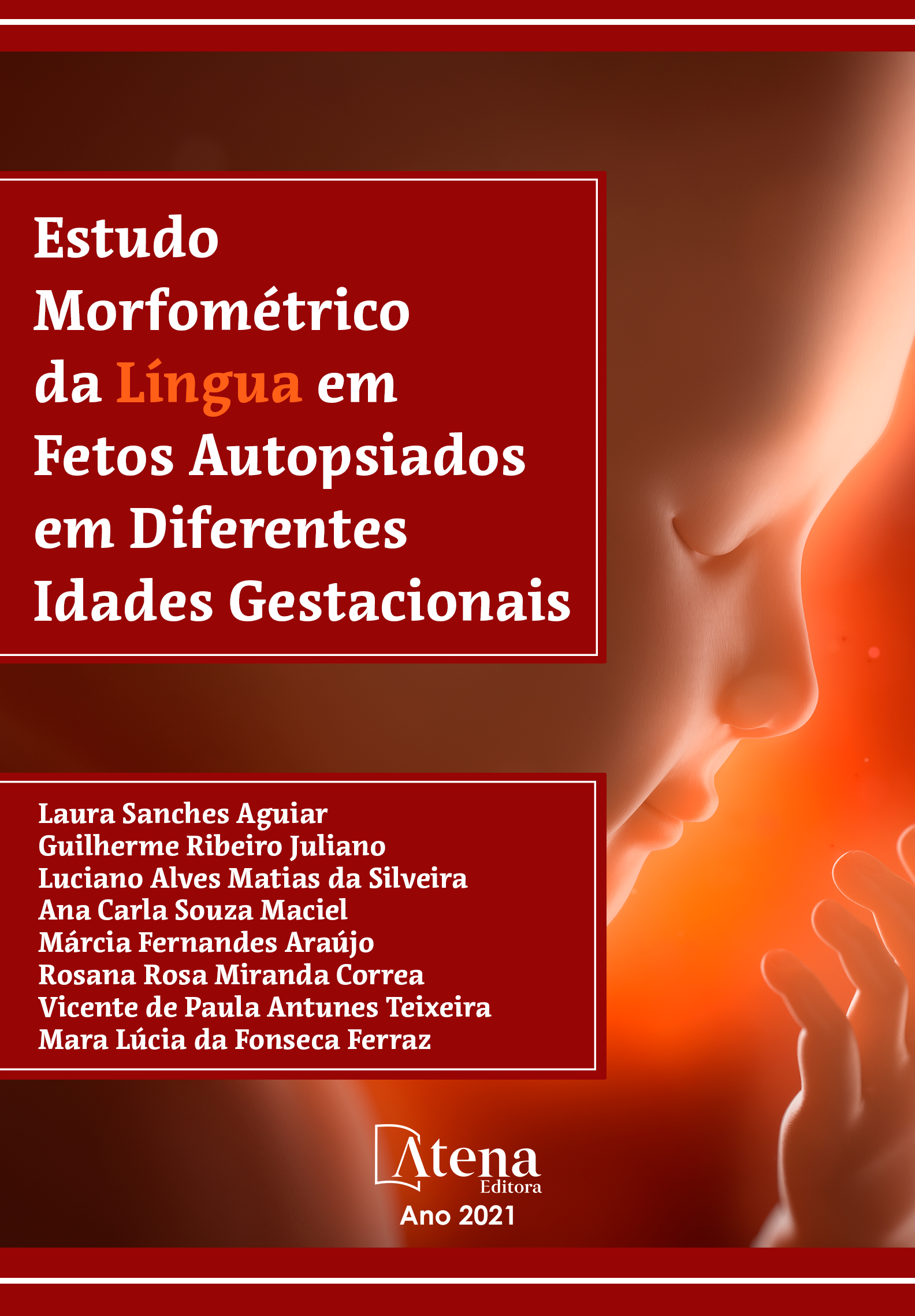
ESTUDO MORFOMÉTRICO DA LÍNGUA EM FETOS AUTOPSIADOS EM DIFERENTES IDADES GESTACIONAIS
Na autópsia, a estimativa da idade gestacional (IG) é importante para reconhecer se o desenvolvimento fetal é consistente com a IG, determinar o tempo de morte em relação ao nascimento, determinar o diagnóstico de doenças específicas ao desenvolvimento do estágio e os possíveis riscos no período neonatal. O objetivo deste estudo foi analisar, por método morfométrico, o perímetro e o comprimento da língua, das fibras de colágeno, do perímetro dos vasos sanguíneos, em IG diferentes e em relação ao peso fetal. Materiais e Métodos: 56 natimortos autopsiados pela Disciplina de Patologia Geral do Hospital das Clínicas da Universidade Federal do Triângulo Mineiro, Uberaba, MG, de 1994 a 2015. As línguas dos natimortos (23 a 40 semanas de IG) foram analisadas macroscopicamente, fotografadas e medidas em comprimento e perímetro. Foram coletados fragmentos por meio de uma secção longitudinal na região que acompanha o sulco lingual médio e processado histologicamente. As lâminas foram coradas com picrosirius e imunomarcadas com anticorpo CD31. A quantificação foi realizada em fibras de colágeno sob luz polarizada e o perímetro de vasos com o marcador CD31 na seção longitudinal da língua, em diferentes IGs, foi definido por 4 quadrantes e 10 campos por quadrante da seção histológica foram analisados. As medições foram feitas utilizando uma câmara de vídeo acoplada a um microscópio de luz comum e a um computador com o sistema de análise de imagem Axiovision SE64. As medições do perímetro dos vasos sanguíneos foram realizadas utilizando o Image J®. Para a análise estatística foi elaborada uma planilha do programa Microsoft Excel®. As informações foram analisadas pelo programa eletrônico GraphPad Prism® versão 5. Para verificar o tipo de distribuição das variáveis foi aplicado o teste estatístico de Shapiro-Wilk. Para correlação, utilizou-se o coeficiente de correlação de Spearman (rS) para distribuição não normal. As diferenças foram consideradas estatisticamente significativas quando p foi menor que 5% (p <0,05). Resultados: Foi encontrada uma correlação positiva e significativa de IG com o perímetro e o comprimento da língua. Houve correlação positiva e significativa entre fibras de colágeno e IG; Bem como entre IG o perímetro dos vasos sanguíneos; E entre fibras de colágeno e peso fetal houve um aumento positivo e significativo. Quanto à correlação entre o perímetro dos vasos sanguíneos e o peso fetal, observou-se aumento, mas com tendência significativa. Conclusão: à medida que o IG avança, há um aumento no perímetro lingual e comprimento, um aumento na porcentagem de fibras de colágeno e um aumento no perímetro vascular, demonstrando que a formação da língua está diretamente relacionada ao crescimento e desenvolvimento da língua.
ESTUDO MORFOMÉTRICO DA LÍNGUA EM FETOS AUTOPSIADOS EM DIFERENTES IDADES GESTACIONAIS
-
DOI: https://doi.org/10.22533/at.ed.968210207
-
Palavras-chave: idade gestacional, natimorto, autópsia
-
Keywords: gestational age, stillborn, autopsy
-
Abstract:
Introduction: In autopsy, the estimation of gestational age (GA) is important to recognize if the fetal development is consistent with the GA, to determine the death time in relation to the birth, to ascertain the diagnosis of diseases that are specific to that developmental stage and possible risks in the neonatal period. The objective of this study was to analyze, through the morphometric method, the perimeter and length of the tongue, the collagen fibers, the perimeter of blood vessels, at different GAs and in relation to the fetal weight. Material and Methods: 56 stillborns autopsied by the General Pathology Discipline at the Clinical Hospital of the Federal University of Triângulo Mineiro (HC/UFTM), Uberaba, State of Minas Gerais, from 1994 to 2015. Tongues of stillborns autopsied (23 - 40 weeks of gestational age) were macroscopically analyzed, photographed and measured for length and perimeter. 56 fragments of the tongues were collected through a longitudinal section in the region that accompanies the median lingual sulcus and histologically processed. Slides were stained with picrosirius and immunolabeled with CD31 antibody. Quantification was performed on collagen fibers under polarized light and the perimeter of vessels with the CD31 marker in the longitudinal section of the tongue, at different GAs, was defined by 4 quadrants and 10 fields per quadrant of the histological section were analyzed. Measurements were taken using a video camera coupled to a common light microscope, and to a computer with the image analyzer system Axiovision SE64. The measurements of the perimeter of blood vessels were taken using Image J® Software. For the statistical analysis a spreadsheet of the program Microsoft Excel® was elaborated. The information was analyzed using the electronic program GraphPad Prism® version 5. To verify the type of distribution of the variables the statistical test of Shapiro-Wilk was applied. For correlation, the Spearman correlation coefficient (rS) was used for non-normal distribution. The differences were considered statistically significant when p was less than 5% (p <0.05). Results: A positive and significant correlation of GA with the perimeter and length of the tongue was found. There was a positive and significant correlation between collagen fibers and GA; as well as between GA and the perimeter of blood vessels; and between collagen fibers and fetal weight there was a positive and significant increase. Regarding the correlation between the perimeter of blood vessels and the fetal weight, there was an increase, but tendency significant. Conclusion: As the GA advances, there is an increase in the lingual perimeter and length, an increase in the percentage of collagen fibers and an increase in the vascular perimeter, demonstrating that tongue formation is directly related to tongue growth and development.
-
Número de páginas: 44
- Guilherme Ribeiro Juliano
- Luciano Alves Matias da Silveira
- Ana Carla Souza Maciel
- Márcia Fernandes Araújo
- Rosana Rosa Miranda Correa
- Vicente de Paula Antunes Teixeira
- Mara Lúcia da Fonseca Ferraz
- LAURA SANCHES AGUIAR


